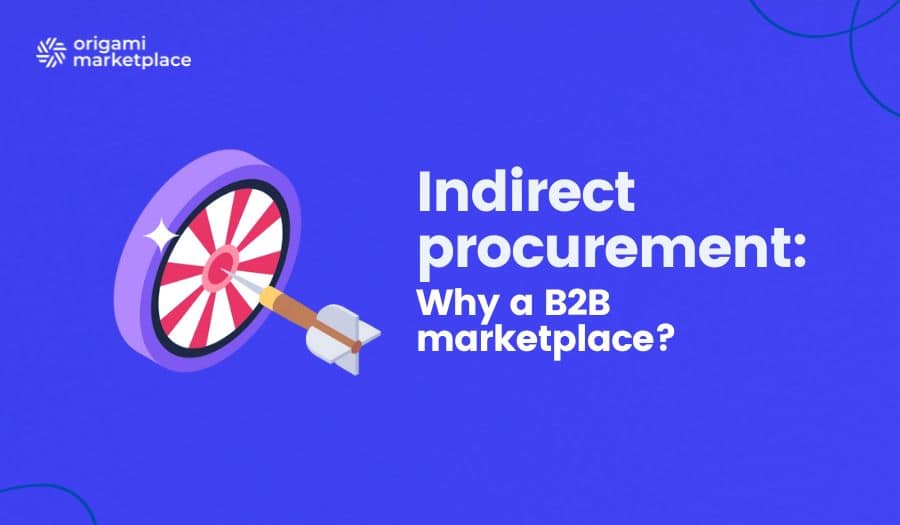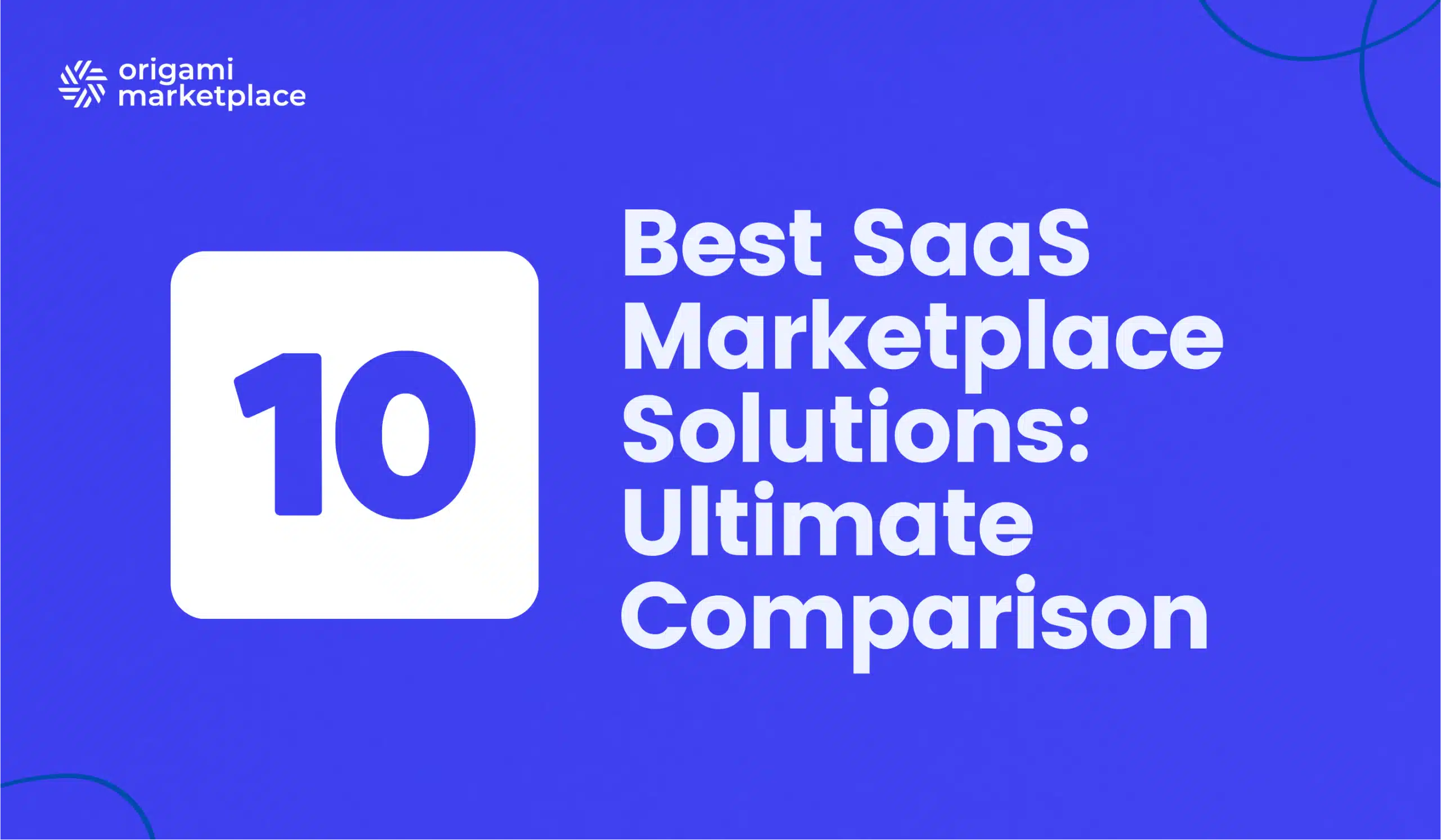Indirect procurement: how the B2B marketplace is becoming a lever for rationalisation and compliance
- Emeline Kerloch
- 11 minutes reading

While indirect purchases, including supplies, services and IT equipment, account for a substantial portion of overall business expenses, their decentralised nature often makes them invisible and difficult to manage. Traditionally, rigid and unintuitive e-procurement systems (ERP and S2P suites) have fuelled uncontrolled purchasing, undermining efforts to centralise spending.
In response to this challenge, the B2B marketplace has emerged as a disruptive solution. By placing the B2C-inspired user experience at the heart of its architecture, it channels spending while offering radical simplicity in identifying and comparing multiple suppliers.
This article explores how the B2B marketplace transforms indirect procurement into a smooth, compliant and manageable process by streamlining the offering and providing granular data tracking via effective dashboards.
- The strategic context: repositioning indirect procurement within the digital ecosystem
- User experience (UX) is the driving force behind internal adoption (B2C-like).
- Mastering product searches among offers
- Ease of comparison and transparency in the multi-supplier market
- Streamlining and managing purchases via an effective dashboard.
- Conclusion: the B2B marketplace is the architect of the agile purchasing ecosystem.
I. The strategic context: repositioning indirect procurement within the digital ecosystem
The economic and strategic importance of indirect spending
Managing indirect procurement presents companies with a significant structural challenge. Historically, this type of spending has tended to be distributed and decentralised, resulting in a lack of clear, formal governance.
This lack of visibility creates a strategic paradox. On the one hand, indirect purchases represent a significant proportion of total expenses: often between 25% and 40%, and sometimes even 35% to 60% of a company’s budget. However, this lack of control makes them seem less strategic than direct procurement, which receives management attention.
Nevertheless, indirect spending has a critical influence on modern business pillars such as operational resilience, employee satisfaction, ESG (environmental, social and governance) objectives, and innovation potential. Therefore, developing a structured purchasing strategy is essential in order to control this expense, and digitalisation is a powerful catalyst for the sustainable transformation of these practices.
Diagnosing Failure in Rigid Systems (ERP and S2P Suites)
The inadequacy of traditional tools is often the root cause of failure in indirect procurement management. ERP systems are often considered too complex and unintuitive for internal users. Similarly, although source-to-pay suites are rich in features, they have historically been designed for experts in the field, imposing a level of complexity that deters the vast majority of employees (estimated at 99%).
This rejection phenomenon has serious financial and strategic consequences in the form of maverick spending. When faced with a tool considered too rigid or difficult to access, employees naturally bypass it. This maverick spending undermines centralisation and negotiation efforts. Although maverick spending represents only a small portion of the total purchasing volume, it can generate up to 70% of total administrative processing costs. The tool’s complexity thus becomes the main obstacle to achieving a return on investment and ensuring compliance.
"When faced with impractical rigid systems, 99% of employees simply bypass the tool. These "unauthorised" purchases alone account for up to 70% of total administrative processing costs, demonstrating that the cost of complexity far exceeds the expense itself.”

Julien Bruitte
II. User experience (UX) is the driving force behind internal adoption (B2C-like).
User experience (UX) is the ultimate judge of procurement performance.
The B2B marketplace offers a radical solution by taking the opposite approach. Rather than imposing rigid controls, it encourages adoption through simplicity. User experience (UX) is not a minor factor, but the main driver of return on investment in the digitalisation of procurement.
The B2B marketplace platform succeeds where S2P suites fail by offering a radically simple experience inspired by the consumer websites that employees use every day. This intuitive design makes the marketplace the easiest way to buy, naturally bringing spending back under the control of the company. Centralisation translates into simplicity and fluidity for business teams, redefining the purchasing department’s role as facilitator rather than ‘policeman’. Intuitive platforms and transparent rules facilitate internal buy-in, as demonstrated by massive adoption rates exceeding 85% thanks to a smooth purchasing experience.
Risk management through UX (aligning simplicity with compliance)
Improving the user experience (UX) has a direct strategic impact on risk management and compliance. A poor user experience wastes time and actively pushes employees towards external ordering channels, such as B2C merchant sites or direct suppliers, that are prohibited by internal purchasing policy.
By offering a simple, integrated solution, the marketplace can help to regain control of spending. This centralisation is essential for reducing the risk of non-compliance, which decentralised procurement cannot control. The platform enables you to create a centralised supplier database, ensuring that each partner has been pre-approved and audited, and complies with internal requirements (CSR, legal regulations, GDPR). Thus, the simplicity of the UX becomes the first line of defence against the risks of legal disputes, critical dependency and operational errors resulting from the use of unaudited service providers.
Ready to transform your procurement?
To help you develop the best platform possible, we’ve gathered all the must-have features, key technical considerations, and best practices in a comprehensive document:
Download the Specifications template 🗒
Perfect for smaller or medium-scale projects without a formal purchasing process. It will help you outline your requirements effectively and streamline your selection process.
Download the Request for Proposal template 📒
Ideal for larger, more complex marketplace projects with a formal purchasing department or advanced procurement policies.
III. Mastering product searches among offers
Ease of finding an identified item
The ease of finding an identified type of product is a prerequisite for adoption. This applies to both standard items such as a ballpoint pen and specific technical equipment. However, analysis shows that B2B purchasing digitisation projects, which are often focused on choosing an e-procurement solution and implementing approval workflows, frequently neglect the quality of electronic catalogue content.
B2B marketplaces clearly stand out from source-to-pay solutions and rigid e-procurement systems in terms of ease of navigation. With traditional tools, even searching for a common item can be laborious: users are often forced to individually navigate through each supplier’s catalogue to check whether the desired product is available. If not, they must leave that catalogue, select the next one and repeat the process. The B2B marketplace, on the other hand, acts as a centralised search engine, aggregating offers from all listed suppliers within a single interface.
When an employee needs a product, their main concern is ensuring that it will meet their intended use. If the internal tool provides low-quality content, such as limited descriptions, poor photos, incomplete technical attributes or a lack of technical data sheets, placing an order becomes risky. This need for information is particularly important for Class C purchases, where the product is rarely purchased and documentation is more important.
The crucial distinction: B2B vs. B2C content
The importance of providing a user experience similar to that of B2C does not mean that B2B content can be used interchangeably with mass-market content. While there is some common ground, such as photos and structure, B2B content must incorporate specific and detailed requirements that are crucial for professional use.
The absence of technical and compliance information can lead to deviations and increased risk. Employees need precise answers about safety and functionality: ‘Can acid be put in this tank?’ and ‘Do these desks comply with fire safety standards?’ For products such as safety footwear, B2B content requires details of the environments in which the footwear will be used, its fire resistance and the weight supported by the protective shell. Technical data sheets and warranty certificates must also be provided. B2C websites often lack sufficient guarantees regarding the accuracy of technical information or the origin of the product.
Standardised hybrid content: ensuring compliance
Poor content is often the direct cause of low adherence to internal procurement policies. Efforts to simplify the user experience are undermined when the technical information required for compliance is missing, which can expose the company to operational errors or risks.
The strategic solution to this problem is to collaborate with specialised B2B distributors who have developed high-quality content. This content combines B2C best practices, such as multiple photos and videos, with the B2B requirements of comprehensiveness and standardisation. This specific information is essential for comparing product characteristics and ensuring secure, compliant choices. Connected via systems such as punch-out or APIs, this content guarantees users a seamless experience that meets the company’s professional requirements.
IV. Ease of comparison and transparency in the multi-supplier market
Centralised competitive bidding
The B2B marketplace is a multi-supplier portal that brings supply and demand together in one place, making business-to-business transactions simpler. It connects suppliers and professional buyers, enabling the latter to compare offers and place orders in one place. One of the main motivations for professional buyers using a B2B marketplace is comparing supplier offers, with the aim of finding the best proposal for each requirement.
The multi-supplier architecture promotes healthy competition and transparency between suppliers. This competitive dynamic directly reduces purchasing costs.
Advanced comparison mechanisms in B2B
The B2B marketplace must facilitate more than just the display of retail prices. It must incorporate features that are essential for complex business transactions.
The platform should enable buyers to compare prices for the same product offered by different suppliers. In addition, it incorporates advanced multi-supplier features, such as:
- Customised pricing: each supplier must be able to manage their own information (catalogue, prices) and configure customised prices for their specific customers.
- Real-time updates: all product information (stock availability, prices, delivery times, etc.) must be updated in real time in conjunction with suppliers’ information systems.
- Negotiation tools: the platform’s transparency improves the purchasing experience, and as direct competition in the marketplace increases, prices tend to decrease.
Comparing similar and functional items
Indirect procurement is complex, so the platform must support comparisons between offers for the same item and similar items that serve the same purpose.
A standardised database backed by verified B2B technical information is essential for this. This ensures that all product characteristics can be evaluated with the required rigour, enabling buyers to select the option best suited to professional use and avoid potentially risky or non-compliant choices.
V. Streamlining and managing purchases via an effective dashboard.
Operational and contractual rationalisation
Centralising indirect procurement processes has become essential for modern procurement departments. It offers multiple benefits in terms of rationalisation:
- Gains in negotiation and economies of scale: centralisation allows purchasing volumes to be pooled to obtain more competitive pricing. It facilitates contract negotiation across multiple sites or countries.
- Process automation: standardising workflows automates the entire purchasing process, from requests and hierarchical or budgetary approvals to order generation and invoice reconciliation. This generates significant administrative time savings, reduces errors, and improves the reliability of data transmitted to finance teams.
- Supplier panel control: The platform helps streamline the supplier panel, limiting off-market purchases and ensuring purchases are made from validated, compliant partners.
Clear tracking dashboard
In order to transform a time-consuming process into a source of value, the platform must enable the simple and clear tracking of orders for each product via a centralised dashboard. This management interface is essential for monitoring the budget commitments of the procurement department.
As a transaction operator, the marketplace captures, records and reports all data. This detailed procurement data collection (services, direct and indirect purchases) forms the basis for spending analysis. This strategic analysis is based on:
- The categorisation of all expenditure data using a logical taxonomy that groups similar types of expenditure together. This grouping enables expenditure to be tracked for functional categories (e.g. office supplies), which include similar but different products (e.g. liquid correction fluid vs. correction tape).
- Access to visibility at stock unit (SKU) level. While product-level reporting provides an overview, SKU-level analysis (e.g. of specific variants, colours or formats) reveals hidden trends and the real impact on margins. Having visibility at SKU level enables you to accurately track annual expenditure for each product and inform strategic decisions to optimise flows.
The marketplace facilitates the generation of consolidated reports, enabling teams to analyse data easily and prioritise sourcing and procurement strategies. It is crucial to track results, including communicating usage rates and savings generated.
Ready to digitize your procurement?
Let’s talk. Our expertise goes beyond software, we help you structure your project with the right roadmap to ensure success.

Conclusion: the B2B marketplace is the architect of the agile purchasing ecosystem.
Digitising indirect procurement via the B2B marketplace is a strategic requirement that goes beyond simply having an online presence. The success of this model hinges on a well-defined causal cycle: a user experience inspired by B2C is fundamental to internal adoption. This ensures that spending is channelled within a controlled framework, significantly reducing the risk of non-compliance and the costs generated by uncontrolled purchasing.
However, streamlining the interface must be supported by high-quality, standardised B2B content. Without full, verified technical information, the user experience is compromised, leading to resistance and migration to unaudited channels. Once this condition is met, the platform can deliver on its value proposition of transparent, multi-supplier competition and complete operational streamlining. Centralised management, made possible by dashboards that provide accurate, consolidated KPIs, transforms the procurement function from a time-consuming activity into a source of strategic control and economies of scale.
By enabling procurement departments to orchestrate their own procurement ecosystems, the B2B marketplace provides them with the platform they need to control indirect expenses that are essential to the resilience and overall performance of the business.
🚀 For those who are short on time, here is a 30-second summary of the article.
💪 The challenge: indirect purchases are scattered and poorly managed by rigid S2P/ERP tools, leading to maverick spending.
🔥 The solution: the B2B marketplace.
🤍 Adoption through UX: a simple, B2C-inspired user experience ensures high internal adoption rates and naturally channels spending.
🔍 Effective search: a centralised search engine that aggregates multi-supplier offers, enabling products to be found instantly and contrasting with the laborious catalogue-by-catalogue navigation of traditional systems.
✅ Compliance and quality: it requires standardised, detailed B2B product content (technical specifications and compliance information) to enable informed choice and rigorous comparison of offers.
🚀 Strategic management: centralisation of transactions feeding into a dashboard providing granular visibility of expenditure by product (SKU) and functional category, essential for rationalisation and achieving economies of scale.
👉 Need a ready-to-go solution? Contact a specialist provider such as Origami Marketplace to accelerate your project. Find out how our API and network of partners can transform your business, regardless of its size, through the marketplace model.


